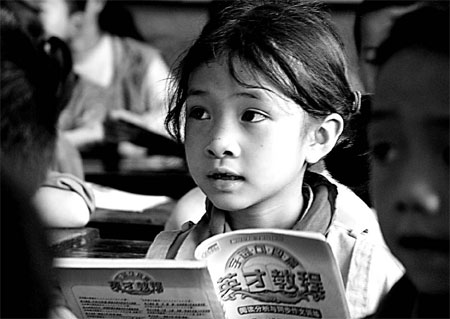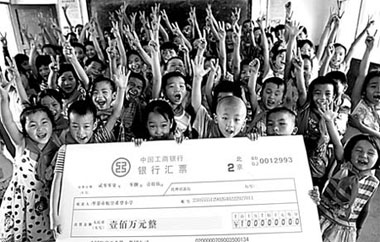The business of giving
 |
|
A Miao girl studies at a primary school built by Project Hope in Danzhai County, Southwest China's Guizhou Province. Zhao Hui |
Previously an NGO practitioner active in Hong Kong, Mar was approached by the international philanthropic organization Project HOPE (Health Opportunities for People Everywhere) in 1996 when it was planning the Shanghai Children's Medical Center. The CMF was set up in 1997 as a subsidiary of Project HOPE to raise funds and build the hospital.
Paradoxically, the initial reaction to Mar's work was doubt - over the organization's ability, the effectiveness of its project and even Mar's motives.
It took years for Mar to earn trust from her local

partners. But Mar understands this.
"Maybe Chinese are more cautious. But you can't blame them. China has had a turbulent history: the war, the 'cultural revolution' People have been poor for a long time. It takes time for people to overcome the instinct to protect themselves," she says.
On the flip side, "once the trust is built, people here are wonderful to work with", Mar says.
Another learning curve for Mar was accountability. Initially it was difficult for her to get reports and financial accounts from program partners.
NGO accountability was a novel concept in the Chinese mainland then. And Mar's insistence on having proof of every expense was seen as troublesome and even disrespectful, threatening to spoil the co-operative relationship.
"I kept telling them: 'This is not my money. Somebody donated it and I must make sure the donated funds are properly spent. I need your help to make sure this is the case,'" she says.
Mar structured a whole set of rules on spending. Signature-bearing receipts, for example, are required to claim expenses instead of fa piao (invoices).
"Fa piao are not useful. They simply say '100 yuan'. But I want receipts, saying who received the money and what it is spent on," Mar says.
The process was long and painful but eventually a system of accountability took root. "Now they know: Mrs Mar won't reimburse without proper receipts," Mar says.
Progress is obvious after 10 years. But the rapid development of China has not helped the CMF in one aspect - fund raising. Though relations with existing benefactors are strong, the CMF found it harder to persuade new donors to contribute to Chinese projects.
 |
|
Students at a primary school in Huayin, Chongqing Municipality, receive a donation of 1 million yuan from a Chinese company. Qiu Haiying |
"People are thinking Chinese are rich now so they can take care of their own," Mar says.
But the state-of-the-art skyscrapers and showrooms for Bentley cars in big cities can be misleading.
"I tell them: 'You have only been to Beijing, Shanghai and Guangzhou. But they are only 10 percent of China. If you want to see the other 90 percent, come with me inland.'"
A dreaded task
Official statistics put charitable donations on the mainland at 10 billion yuan ($1.3 billion) last year, a paltry 0.5 percent of GDP as compared with 2 percent in the United States. The nouveau riche entrepreneurs are often criticized for being tight-fisted.
Mar believes the mainland still lacks incentives for people to donate. The March 2007 Law on Corporate Income Tax has raised the tax-deductible donations from 3 percent of an enterprise's annual profit to 12 percent. But even the former 3 percent is not being implemented.
And Mar knows better than anyone that fund-raising has never been a strong suit of Chinese charity workers.
"Chinese are reluctant to do fund raising. Do you know why? We are afraid of losing face," Mar says. Asking for money itself is seen as humiliating, not to mention the possible rejection.
As a veteran fundraiser, Mar has two pieces of advice.
"First, one should not view fundraising as something personal. It isn't," she says. It's a charity worker's job to solicit donations, just like a visit to an orphanage. "Rejection should not affect you, or your relationship with the donor. It's all in a day's work."
Moreover, fundraisers should not see themselves as "beggars". "Rather, you're giving people an opportunity to do good," she adds.
Mar also says it is important to identify the unique value of an organization.
"You want to help children? Fine. There're 100 organizations out there helping children. Why should a donor give to you? What makes you special? And how are you going to ensure quality and accountability? These are questions every organization should ask itself."
In terms of project development, the CMF's approach is to identify a need, develop a program on a small scale and then replicate the model elsewhere.
Some projects stem from suggestions from the CMF's partners and some from observation, Mar says. The neonatal intensive care program, for example, was inspired by conversations with doctors participating in the CMF's western training program.
Responding to the lack of intensive care for newborns in rural hospitals, the CMF set up the first unit in a county hospital in Longyou, Zhejiang Province in 2002. With donations from a businessman from Zhejiang, the CMF purchased equipment for the hospital and paid for the training of two doctors and two nurses at the Shanghai Children's Medical Center.
The model has since been replicated in nine hospitals in Zhejiang, Sichuan, Guizhou, Guangxi, Ningxia and Inner Mongolia. The infant mortality rate has fallen 17 percent as a result.
Health care for the underprivileged is a mammoth task but Mar believes in addressing one need, and helping one group at a time.
"Or, you'll never get started," she says.
(China Daily 11/21/2007 page20)














